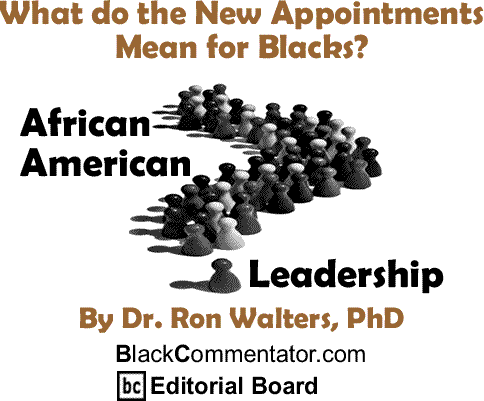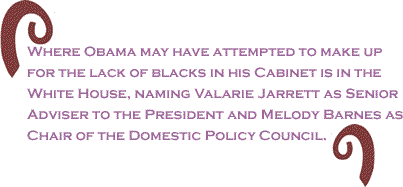
|
|||||||||||||||||||||||

|
|

Custom Search
|
|
 |
|
I’m not sure we are covered by the current appointments. It depends on how President Barack Obama intends to govern. Since 1964 there have been 13 black cabinet appointments, one third of them by Bill Clinton and another third by George Bush, and the rest spread among the other presidents. Most of these appointments were to Housing and Urban Development, two were to Transportation, two to Secretary of State and the rest to other agencies. Before the Obama administration, the only offices blacks had not been appointed to were Attorney General, Treasury, Defense, and Interior and now Eric Holder has been appointed to be the next Attorney General. But in the last Democratic administration Bill Clinton, there were three black Cabinet appointments in his first administration (Hazel O’Leary – Energy, Mike Espy – Agriculture, Ron Brown – Commerce) and three in his second administration (Alexis Herman – Labor, Rodney Slater – Transportation, and Togo West – Veterans Affairs). With the Cabinet picks of Obama now finished, Eric Holder is the only bonafide Cabinet selection, and Susan Rice’s appointment of Ambassador to the United Nations does not place her in the center of the administrations foreign policy apparatus that is usually held down by the Secretary of State and/or the National Security Adviser to the President. In most articles, some non-traditional posts have been included in the list of black “Cabinet” appointments, such as Ron Kirk as U. S. Trade Representative and Lisa Jackson as Director of the Environmental Protection Agency. Whether these appointees have access to the President and are treated as, in effect, Cabinet appointments depends upon how the president governs. However, it is certain that with respect to the size and budget of their office, they are not comparable to a traditional Cabinet office, but EPA may come in for serious upgrading because of Obama’s emphasis on the Environment and his economic plan that focuses on this sector of the economy for employment expansion. To this extent, Barack Obama’s Cabinet has fewer Blacks than Bill Clinton’s Cabinet. In comparison, Hispanics have two traditional Cabinet appointments (Ken Salazar – Interior, and Hilda Solis – Labor). Asians have two of the traditional Cabinet appointments (Steven Chu – Energy, and Eric Shinseki – Veterans). Where Obama may have attempted to make up for the lack of blacks in his Cabinet is in the White House, naming Valarie Jarrett as Senior Adviser to the President and Melody Barnes as Chair of the Domestic Policy Council. It is interesting that the Office of Urban Policy went to an Hispanic, Adolfo Carrion, Jr. This would seem to signal that more than ever before the direction on policy formulation will be coming from the White House, as also indicated by the role of Tom Daschle who will be both Secretary of Health and Human Services and Chair of a White House Committee on Health Reform, and Lawrence Summers who will coordinate the White House approach to resolving the economic crisis. Bill Clinton did not have African Americans in major policy positions in the White House, nor located in his inner circle. However, the presence of Valarie Jarrett and Melody Barnes should be comforting in that respect, since Jarrett, in a recent meeting with Black journalists was reported to give a resounding “no” to the question of whether Obama would forget his obligation to black people, given their strong support of his election.
So, despite the fact that there are not as many blacks in traditional Cabinet posts as in the last Democratic administration, it looks as if the essential direction on policy will come from within the White House, from those who could be trusted to do the right thing. In this respect, the role of Adolfo Carrion, Jr. should be watched, not only because the White House office on Urban Policy is a new entity, but for whether it achieves the necessary synergy with the Department of Housing and Urban Affairs, Labor and Education to make a real difference in the lives of those who live in metro areas. This would appear to place great weight on Carrion, a Puerto Rican and the former Bronx Borough President in New York, who campaigned heavily for Obama in largely Hispanics areas across the country and has managed to stay above the political fray in his locality. He won election in a contest with another Puerto Rican, State Senator, Pedro Espanada, Jr. and a white female, Council woman, June Eisland, in a borough that was at least 40% black. It should be said, then that blacks were the deciding vote in his election and therefore, would support his elevation this post. Whether support for Carrion holds true for blacks nationally depends upon the enthusiasm and excellence with which he deals with issues that empower them. A graduate from Hunter College with a degree in Urban Planning and a former employee with the City planning Department in one of the largest cities in the nation, he could be a credible appointee to this position. But whether he grasps the history of the failures of urban policy in the past two decades and crafts new approaches that stimulate economic development of poor neighborhoods, provides upward employment mobility for working class blacks, and promotes fair access to jobs and business financing, remains to be seen. BlackCommentator.com
Editorial Board member
Dr. Ron Walters is the Distinguished Leadership Scholar, Director
of the African American Leadership Center and Professor of Government
and Politics at the University of Maryland College Park. His latest
book is: The
Price of Racial Reconciliation (The Politics of Race and Ethnicity) |
|
Any BlackCommentator.com article may be re-printed so long as it is re-printed in its entirety and full credit given to the author and www.BlackCommentator.com. If the re-print is on the Internet we additionally request a link back to the original piece on our Website. Your comments are always welcome. eMail re-print notice
If you send us an eMail message we may publish all or part of it, unless you tell us it is not for publication. You may also request that we withhold your name. Thank you very much for your readership. |
|
| |
|































